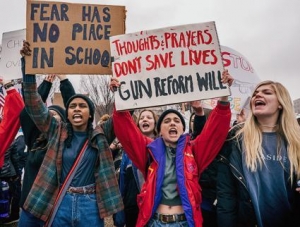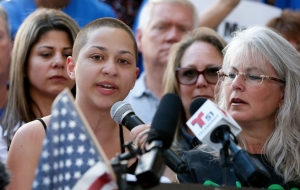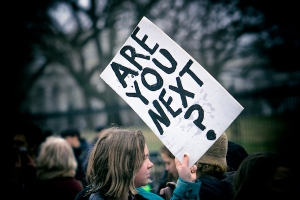Seven Insights to Help You Make Sense of Gun Violence
Research can help us understand why guns are killing more Americans—and what we can do to stop it.
In the first decades of the 21st century, the United States has been engaged in a large-scale social experiment revolving around this question: What happens when we flood communities with firearms of all types, from handguns to assault rifles, and lift restrictions on our ability to carry and use them? We now have years of data.
Today, guns kill almost 39,000 Americans a year. That’s 22 percent more than when President Obama was elected in 2008. For every killing deemed self-defense by the police, guns are used in 34 homicides and 78 suicides. At this point, there is little question that more guns lead to more dead and wounded Americans—a conclusion ratified by two new studies published this month, one in the journal JAMA Internal Medicine, the other a comprehensive review of thousands of studies from the RAND Corporation.
 Students rally for gun reform in Washington, D.C.© Lorie Shaull | flickr
Students rally for gun reform in Washington, D.C.© Lorie Shaull | flickr
These statistics raise a question: What motivates Americans to buy so many guns?
There is fear, of course. Far from making guns less desirable, high-profile shootings compel Americans to go out and buy more. This run to the gun shop often translates into policy: In the United States, mass shootings lead to looser, not stricter, gun regulations, which in turn put more guns in our homes and on our streets—which results in more injury and death.
But there is more to our motivations than a reflexive desire to defend ourselves and our families from threats both real and imagined. We also want to belong and to exclude, and studies are finding that guns have become emblems of in-group membership. These affiliations gradually shape the meaning we give to our own lives and our sense of purpose. In this way, guns reveal how entwined our lives can be with other people’s, even as they make it more likely that we’ll hurt each other.
We have understood for a long time that social networks affect our emotions and behavior in ways both positive and negative. Happiness and kindness are contagious, transmitted through networks of family, friends, classmates, neighbors, coworkers, and so on. When conditions are healthy, social networks can support our well-being. But fear and anger are contagious, too, corroding our health and undermining our relationships. Just as diseases can jump from person to person, so too can violence. The key is to break people’s connection with their guns, by helping them to stay connected with a diverse group of people who might help give their life meaning.
Here are seven insights from scientific investigations into human strengths, weaknesses, and relationships that might help us to understand why America is seeing more and more gun violence—and what we can do to stop it.
1. Gun violence spreads through social networks
In a series of studies, sociologist Andrew Papachristos and colleagues have looked at the impact of gun violence on social networks—that is, “six degrees of separation,” the person-to-person chains of friends, neighbors, and family that weave themselves together to make up a society.
When Papachristos and colleagues ran an epidemiological analysis of people arrested during an eight-year period in Chicago, they found that shooting victims “infected” others in their network. In other words, if you know someone who is shot, the probability skyrockets that you will be shot, too—on average, 125 days after the previous incident. In a 2012 study of almost 800 people in Boston, Papachristos found that 85 percent of all gunshot injuries occurred within a single social network. In a review of 16 studies published between 1996 and 2015, Papachristos and colleagues found, again, “high concentrations of gun violence in small networks”—and that gunfire in your group greatly increased the likelihood that you’d be shot. This is particularly intense in networks of impoverished, urban black men, who are eight times more likely to be shot than their white counterparts.
The bottom line: Most murders and shoot-outs don’t happen between strangers. They unfold within social networks, usually among people of the same race. Most of the time, the dead and wounded know the people who shot them.
2. A small number of Americans are stockpiling weapons
Skyrocketing gun sales don’t mean more households have guns than ever before—that percentage has stayed fairly steady for decades. Rather, more guns are being stockpiled by a small number of individuals. A recent, large-scale study from the Injury Control Research Center at Harvard University finds that three percent of the population now owns half of the country’s firearms.
“When men became fathers or got married, they started to feel very vulnerable, like they couldn't protect families. For them, owning a weapon is part of what it means to be a good husband and a good father.”
So, who is buying all these guns—and why?
The short, broad-brush answer to the first part of that question is this: men, who on average possess almost twice the number of guns that female owners do. In particular, the American citizen most likely to own a gun is a white male—but not just any white guy. According to a growing number of scientific studies, the kind of man who stockpiles weapons or applies for a concealed-carry license meets a very specific profile.
3. For many white men, guns are a source of meaning and purpose
Baylor University sociologists Paul Froese and F. Carson Mencken created a “gun empowerment scale” designed to measure how a nationally representative sample of almost 600 owners felt about their weapons. Their study found that people at the highest level of their scale—the ones who felt most emotionally and morally attached to their guns—were 78 percent white and 65 percent male.
“We found that white men who have experienced economic setbacks or worry about their economic futures are the group of owners most attached to their guns,” says Froese. “Those with high attachment felt that having a gun made them a better and more respected member of their communities.”
That wasn’t true for most women and people of color. In other words, they may have suffered setbacks, but they didn’t turn to guns to make themselves feel better. “This suggests that these owners have other sources of meaning and coping when facing hard times,” notes Froese—often, religion. Indeed, Froese and Mencken found religious faith seemed to put the brakes on white men’s attachment to guns.
For these economically insecure, less-religious white men, “the gun is a ubiquitous symbol of power and independence, two things white males are worried about,” says Froese. “Guns, therefore, provide a way to regain their masculinity, which they perceive has been eroded by increasing economic impotency.”
In Froese’s view, stockpiling guns seems to be a symptom of a much deeper crisis in meaning and purpose in the lives of these men. When read in the context of other studies, this research describes a population that is struggling to find a new story—one in which they are once again the heroes.
4. Gun owners want to be the good guys
 Emma Gonzalez, a senior at Marjory Stoneman Douglas High School, addresses a gun-control rally in Fort Lauderdale, Florida, days after a gunman killed 17 people at her school.
Emma Gonzalez, a senior at Marjory Stoneman Douglas High School, addresses a gun-control rally in Fort Lauderdale, Florida, days after a gunman killed 17 people at her school.
When Northland College sociologist Angela Stroud studied applications for licenses to carry concealed firearms in Texas—which “exploded” after President Obama was elected—she found applicants were overwhelmingly married white men. In interviews, they told her that they wanted to protect themselves and the people they love.
“When men became fathers or got married, they started to feel very vulnerable, like they couldn’t protect families,” she says. “For them, owning a weapon is part of what it means to be a good husband and a good father.” That meaning is “rooted in fear and vulnerability—very motivating emotions.”
Investing guns with this kind of moral and emotional meaning has many consequences, the researchers say. As Froese says, “Put simply, owners who are more attached to their guns are most likely to believe that guns are a solution to our social ills. For them, more ‘good’ people with guns would drastically reduce violence and increase civility. Again, it reflects a hero narrative which many white men long to feel a part of.”
Stroud’s work echoes this conclusion. “They tell themselves all kinds of stories about criminals and criminal victimization,” she says. “But the story isn’t just about criminals. It’s about the good guy—and that’s how they see themselves: I work hard, I take care of my family, and there are people who aren’t like that. When we tell stories about the Other, we’re really telling stories about ourselves.”
5. Rising gun sales are linked to racial fears
Stroud discovered another motivation, at least for white people: racial anxiety. “A lot of people talked about how important Obama was [in influencing their decision] to get a concealed-carry license: He’s for free health care, he’s for welfare. They were asking, Whatever happened to hard work?” Obama’s presidency, they feared, would empower minorities to threaten their property and families.
The insight Stroud gained from her interviews is backed up by many, many studies. A 2013 paper found that a one-point jump in the survey they used to measure racism increased the odds of owning a gun by 50 percent. A 2016 study from the University of Illinois at Chicago found that racial resentment among whites fueled opposition to gun control. This drives political affiliation: A 2017 study in Social Science Quarterly found that gun owners had become 50 percent more likely to vote Republican since 1972—and that gun culture had become strongly associated with explicit racism.
For many conservatives, the gun feels like a force for order in a chaotic world, suggests a study published in December of last year. In a series of three experiments, Steven Shepherd and Aaron C. Kay asked hundreds of liberals and conservatives to imagine holding a handgun—and found that conservatives felt less risk and greater personal control than their liberal counterparts. This wasn’t about familiarity with real-world guns; gun ownership and experience did not affect the results. Instead, conservative attachment to guns was based entirely on ideology and emotions.
Both Froese and Stroud found pervasive anti-government sentiments among their study participants. “This is interesting because these men tend to see themselves as devoted patriots, but make a distinction between the federal government and the ‘nation,’” says Froese. “On that point, I expect that many in this group see the ‘nation’ as being white.”
6. Humans want peace and avoid violence
 Students rally for gun reform in Washington, D.C.© Lorie Shaull | flickr
Students rally for gun reform in Washington, D.C.© Lorie Shaull | flickr
Despite these worrying trends, we can take comfort in the fact that all the evidence we have indicates that the vast majority of humans do not want to hurt each other. It’s easy and natural to panic when we hear about a new school shooting—or the very real rising tide of violence in America.
This is why we need to consciously remind ourselves of the big picture, which includes the good and the bad, ups as well as downs. In fact, in 2018 we sit near the bottom of a decades-long decline in violent crime. We have good reason to be concerned about the recent jump in gun deaths, but we need to remember that it’s been worse in the past.
“Our daily observations may seem to contradict the idea that peacefulness predominates in human affairs, especially when we have become accustomed to Hollywood films and daily newscasts that depict unrelenting violence,” writes anthropologist Douglas Fry. “In actuality, the vast majority of people on the planet awake on a typical morning and live a violence-free day—and this experience generally continues day after day.”
Indeed, research into real-world violence reveals an overwhelming drive to avoid it, sometimes even at a cost to ourselves. “The study of killing by military scientists, historians, and psychologists gives us good reason to feel optimistic about human nature, for it reveals that almost all of us are overwhelmingly reluctant to kill a member of our own species, under just about any circumstance,” writes Lt. Col. Dave Grossman in his Greater Good essay, “Hope on the Battlefield.”
Why? Our bodies contain a host of biological and psychological mechanisms that bind us together: neurotransmitters and brain structures that help us to perceive and react to another person’s emotional states. We are extremely prone to responding to cues from other people and imitating each other’s behavior. “Humans are hardwired for interactional entrainment and solidarity; and this is what makes violence so difficult,” writes sociologist Randall Collins in his massive study Violence.
In light of this research, how can you explain enjoying a violent superhero movie or an occasional first-person shooter video game? You’re probably not bloodthirsty. In stories, we often imagine nightmares—and this gives us a sense of control over them. Our stories are filled with violence because we worry about violence. Isn’t that why you’ve read this far? Because you’re worried?
I am, too.
7. It is within our power to cultivate healthy social networks
So, what should we do?
Conservatives and liberals may never agree about specific gun-control policies; those are political questions. But we might come together on one, hopefully non-political point: People who feel connected to something larger than themselves are happier, healthier, and less likely to hurt other people.
It’s hard to say what makes a social network toxic and violent. It is incredibly difficult for social scientists to isolate the various forces that act within and upon any given social network to produce this outcome or that one. Poverty makes things harder and education makes things easier, and yet there are groups of impoverished people whose lives are happier and more meaningful than their affluent counterparts’.
This is what we do know: While social networks, like Tolstoy’s families, can be unhappy in different ways, for different reasons, the happy ones tend to be very much alike. The people in them feel connected to each other—and also to people in other networks. They can tolerate and even embrace differences among themselves and with other groups. Healthy networks nurture a sense of meaning and purpose among members, often through spirituality and religious practice, sometimes through political activity. We thrive when we know we’re not alone. Happy individuals try to practice forgiveness, compassion, and gratitude, which might be how their happiness rubs off on others.
Gun violence is not inevitable and we are not helpless. There are research-tested steps we can take, as a society and individuals, to reduce the number of guns and shootings in America. We can take these steps knowing that human nature is on our side—and that we’re in this together.